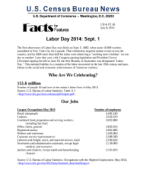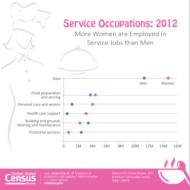Facts for Features: Labor Day 2014: Sept. 1
The first observance of Labor Day was likely on Sept. 5, 1882, when some 10,000 workers assembled in New York City for a parade. That celebration inspired similar events across the country, and by 1894 more than half the states were observing a "working men's holiday" on one day or another. Later that year, with Congress passing legislation and President Grover Cleveland signing the bill on June 29, the first Monday in September was designated "Labor Day." This national holiday is a creation of the labor movement in the late 19th century and pays tribute to the social and economic achievements of American workers.
Who Are We Celebrating?
155.6 million
Number of people 16 and over in the nation's labor force in May 2013.
Source: U.S. Bureau of Labor Statistics, Table A-1 <//www.bls.gov/news.release/pdf/empsit.pdf> [PDF - <1.0 MB]
Our Jobs
| Largest Occupations May 2013 | Number of employees |
| Retail salespeople | 4,485,180 |
| Cashiers | 3,343,470 |
| Combined food preparation and serving workers, including fast food |
3,022,880 |
| Office clerks, general | 2,832,010 |
| Registered nurses | 2,661,890 |
| Waiters and waitresses | 2,403,960 |
| Customer service representatives | 2,389,580 |
| Laborers and freight, stock, and material movers, hand | 2,284,650 |
| Secretaries and administrative assistants, except legal medical, and executive |
2,159,000 |
| Janitors and cleaners, except maids and housekeeping cleaners |
2,101,810 |
Source: U.S. Bureau of Labor Statistics, Occupations with the Highest Employment, May 2013, <//www.bls.gov/oes/2013/may/featured_data.htm#largest>
| Largest Occupations 1910 | Number of employees |
| Farmers (owners and tenants) | 6,132,000 |
| Farm laborers, wageworkers | 2,832,000 |
| Farm laborers, unpaid family workers | 2,514,000 |
| Operatives and kindred workers, manufacturing | 2,318,000 |
| Laborers, nonmanufacturing industries | 2,210,000 |
| Laborers, manufacturing | 1,487,000 |
| Salesmen and sales clerks, retail trade | 1,454,000 |
| Housekeepers, private household - living out | 1,338,000 |
| Managers, officials, and proprietors, retail trade | 1,119,000 |
| Mine operatives and laborers, crude petroleum and natural gas extraction |
907,000 |
Sources: Statistical Abstract, Bicentennial Edition: Historical Statistics of the United States, Colonial Times to 1970, Chapter D: Labor, Part 1, Page 20 of pdf, Series D 233-682. Detailed Occupation of the Economically Active Population: 1900 to 1970 <//www2.census.gov/prod2/statcomp/documents/CT1970p1-05.pdf> [PDF - 6.6 MB]
16.0 million
The number of wage and salary workers age 16 and over represented by a union in 2013. This group includes both union members (14.5 million) and workers who report no union affiliation but whose jobs are covered by a union contract (1.5 million).
Source: U.S. Bureau of Labor Statistics, Table 1 <www.bls.gov/news.release/pdf/union2.pdf> [PDF - <1.0 MB]
14.8 million
Number of female workers 16 and over in service occupations in 2012. Among male workers 16 and over, 11.4 million were employed in service-related occupations.
Source: U.S. Census Bureau, 2012 American Community Survey, Table C24010 <//factfinder2.census.gov/bkmk/table/1.0/en/ACS/12_1YR/C24010>
1.8%
Percentage increase in employment (or 2.3 million) in the U.S. between December 2012 and December 2013. Employment increased in 286 of the 334 largest U.S. counties (large counties are defined as having employment levels of 75,000 or more).
Source: U.S. Bureau of Labor Statistics <//www.bls.gov/news.release/cewqtr.nr0.htm>
Another Day, Another Dollar
$49,398 and $37,791
The 2012 real median earnings for male and female full-time, year-round workers, respectively.
Sources: U.S. Census Bureau, Income, Poverty, and Health Insurance Coverage in the United States: 2012, Table A-4 <//www.census.gov/library/publications/2013/demo/p60-245.html>
Fastest Growing Jobs
49%
Projected percentage growth from 2012 to 2022 in the number of personal care aides (580,800). Analysts expect this occupation to grow much faster than the average for all occupations. Meanwhile, the occupation expected to add more positions over this period than any other is registered nurse (526,800).
Source: U.S. Bureau of Labor Statistics <//www.bls.gov/ooh/>
Employee Benefits
84.5%
Percentage of full-time, year-round workers 18 to 64 covered by health insurance during all or part of 2012.
Source: U.S. Census Bureau, Income, Poverty, and Health Insurance Coverage in the United States: 2012, derived from Table 7 <//www.census.gov/library/publications/2013/demo/p60-245.html>
Say Goodbye to Summer
Labor Day is celebrated by most Americans as the symbolic end of the summer and the start of the back-to-school season.
25,455
The number of shoe stores for back-to-school shopping in 2012. Other choices of retail establishments abound: there were 25,421 family clothing stores, 6,945 children and infants clothing stores, 7,443 office supply and stationery stores, 7,244 bookstores and 8,196 department stores.
Source: U.S. Census Bureau, 2012 County Business Patterns, NAICS: 448210, 44814, 448130, 453210, 451211 and 4521 <//factfinder2.census.gov/bkmk/table/1.0/en/BP/2012/00A1//naics~44813|44814|448210|451211|4521|453210>
20,893
The number of sporting goods stores nationwide in 2012. In U.S. sports, college football teams usually play their first games the week before Labor Day, with the NFL traditionally playing its first game the Thursday following Labor Day.
Source: U.S. Census Bureau, 2012 County Business Patterns, NAICS 451110 <//www.census.gov/econ/cbp/>
53,981
The number of travel agents employed full time, year-round in 2012. In addition, there were 16,526 tour and travel guides employed full time, year-round nationwide. On a weekend intended to give U.S. workers a day of rest, many climb into their drivers' seats or board an airplane for a quick end of the summer getaway.
Source: U.S. Census Bureau, 2012 American Community Survey, Table B24124 <//factfinder2.census.gov/bkmk/table/1.0/en/ACS/12_1YR/B24124>
862,630
The number of paid employees (for the pay period including March 12) who worked for a gasoline station in the U.S. in 2012. Oregon (9,347 paid gasoline station employees) and New Jersey (16,408 paid gasoline station employees) are the only states without self-service gasoline stations. Oregon was the first state to make Labor Day a holiday in February 1887.
Source: U.S. Census Bureau, 2012 County Business Patterns, NAICS 447 <//factfinder2.census.gov/bkmk/table/1.0/en/BP/2012/00A1/0100000US.04000/naics~447>
The Commute to Work
5.9 million
Number of commuters who left for work between midnight and 4:59 a.m. in 2012. They represented 4.4 percent of all commuters. The most common time was between 7 and 7:29 a.m. - with 19.8 million commuters.
Source: U.S. Census Bureau, 2012 American Community Survey, Table B08132 <//factfinder2.census.gov/bkmk/table/1.0/en/ACS/12_1YR/B08132>
4.4%
Percentage of workers 16 and over who worked from home in 2012.
Source: U.S. Census Bureau, 2012 American Community Survey, Table B08128 <//factfinder2.census.gov/bkmk/table/1.0/en/ACS/12_1YR/B08128>
76.3%
Percentage of workers 16 and over who drove alone to work in 2012. Another 9.7 percent carpooled and 0.6 percent biked to work.
Source: U.S. Census Bureau, 2012 American Community Survey, Table S0801 <//factfinder2.census.gov/bkmk/table/1.0/en/ACS/12_1YR/S0801>
25.7 minutes
The average time it took workers in the U.S. to commute to work in 2012. Maryland and New York had the most time-consuming commutes, both averaging about 32 minutes.
Source: U.S. Census Bureau, 2012 American Community Survey, Table R0801 <//factfinder2.census.gov/bkmk/table/1.0/en/ACS/12_1YR/R0801.US01PRF>
For detailed information on the data force, visit the Bureau of Labor Statistics at
<//www.bls.gov/>.
The following is a list of observances typically covered by the Census Bureau’s Facts for Features series:
| Black (African American) History Month (February) Super Bowl Valentine's Day (Feb. 14) Women's History Month (March) Irish-American Heritage Month (March)/ St. Patrick's Day (March 17) Earth Day (April 22) Asian/Pacific American Heritage Month (May) Older Americans Month (May) Mother's Day Hurricane Season Begins (June 1) Father's Day |
The Fourth of July (July 4) Anniversary of Americans With Disabilities Act (July 26) Back to School (August) Labor Day Grandparents Day Hispanic Heritage Month (Sept. 15-Oct. 15) Unmarried and Single Americans Week Halloween (Oct. 31) American Indian/Alaska Native Heritage Month (November) Veterans Day (Nov. 11) Thanksgiving Day The Holiday Season (December) |
Editor’s note: The preceding data were collected from a variety of sources and may be subject to sampling variability and other sources of error. Facts for Features are customarily released about two months before an observance in order to accommodate magazine production timelines. Questions or comments should be directed to the Census Bureau’s Public Information Office: telephone: 301-763-3030; or e-mail: [email protected].





